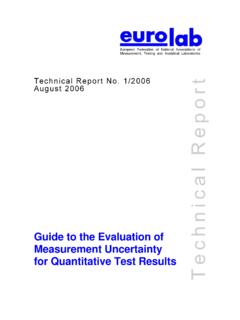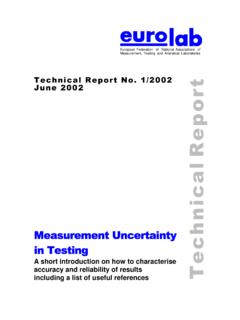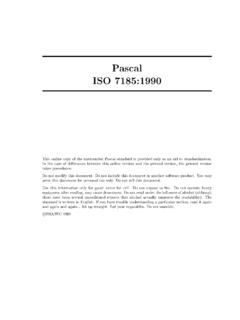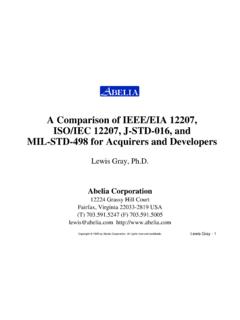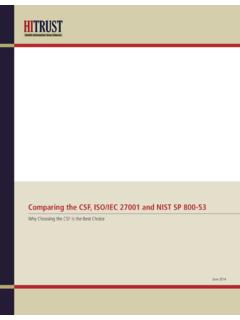Transcription of Handbook ISO/IEC 17025:2017 - EUROLAB
1 Page 1 of 32 Handbook ISO/IEC 17025 :2017 Page 2 of 32 General considerations This new standard ISO/IEC 17025 includes some noteworthy changes related to its structure and scope that should be mentioned before we go into greater details of each section of the standard. Structure: The new structure of the standard is no longer based on the two main chapters (four for Management requirements, and five for Technical requirements) we were used to; to be harmonized with the rest, this one follows the CASCO guidelines for conformity assessment standards, and the structure is more process oriented: Structure requirements Resource requirements Process requirements Management system requirements The standard also includes two Annexes that were not included in the previous version: Informative Annex A, related to metrological traceability Informative Annex B, related to the different options of the laboratory management system Wording: A stronger process orientation and the implementation of risk-based thinking are reflected in a changed way of formulating the requirements.
2 While in the previous edition of ISO/IEC 17025 specific provisions for the implementation in the laboratory have been expressed, the new choice of words is more performance-based and therefore much more abstract. The result or the purpose of certain processes is now embedded in the formulations (performance-based requirements), while the concrete design of the processes (the "how") is left up to the users; consequently, the description of individual process steps has been abandoned. Scope: A new definition of the term laboratory and its activities has been included. In the new version, a laboratory has been defined as an organization that can perform testing, calibration and/or sampling associated with subsequent testing or calibration. The term laboratory activities has been introduced. The resulting new definition of the term laboratory makes clear that laboratory activities do not only include testing and calibration but also sampling, provided that this is in connection with a subsequent test or calibration.
3 For the user, it is important that the appropriate requirements are applied to all three activities whenever the standard speaks of laboratory activities. In the following, this Handbook identifies the major innovations of ISO/IEC 17025 :2017, often in comparison to the previous version, gives suggestions on how to implement the novelties, and recommends further readings on the particular clauses, especially to the CookBooks. Page 3 of 32 RISK BASED THINKING Cross reference ISO/IEC 17025 :2017 ISO/IEC 17025 :2005 Clause Title Clause Title Introduction "Risk based approach" N/A N/A Identification of changes This document requires the laboratory to plan and implement actions to address risks and opportunities. Addressing both risks and opportunities establishes a basis for increasing the effectiveness of the management system, achieving improved results and preventing negative effects.
4 The laboratory is responsible for deciding which risks and opportunities need to be addressed. Suggestions on how to implement the novelties The objectives of risk assessments in the laboratory ( ) are to: a) give assurance that the management system achieves its intended results; b) enhance opportunities to achieve the purpose and objectives of the laboratory; c) prevent or reduce undesired impacts and potential failures in the laboratory activities; and d) achieve improvement. Risk based thinking in a laboratory is not a novelty, but it is promoted in the new standard, although the standard does not stipulate a complete risk management system (RMS), for example conforming to the requirements of ISO 31000. The laboratory is expected to plan and implement actions for addressing risks and opportunities. It is therefore useful to get an overview of the specific risks as well as the corresponding opportunities for the laboratory and to document the results of the risk analysis.
5 Both the risks of producing invalid results including the provision of an invalid statement of conformity ( ) and impartiality risks should be considered ( ). Additionally, risk levels regarding non-conforming work ( ) and invalid statements ( ), such as false accept and false reject as well as statistical assumptions, should be defined for instance by a three-stage quotation system. An acceptable risk should be classified as such. This risk analsysis as well as adequateness of the resulting actions shall be implemented in the management system; it is therefore recommended to address this during the management review ( ). Further readings CookBook N 18 An introduction to risk consideration CookBook N 8 Determination of Conformance CookBook N 7 Management Reviews ISO 31000 Risk management -- Guidelines Page 4 of 32 4.
6 GENERAL REQUIREMENTS IMPARTIALITY AND CONFIDENTIALITY Cross reference ISO/IEC 17025 :2017 ISO/IEC 17025 :2005 Clause Title Clause Title Impartiality Organization Confidentiality c) Organization Identification of changes New harmonized text has been included, so these are completely new clauses. Suggestions on how to implement the novelties Regarding impartiality ( ) It is recommended to write down a document in which, depending on the needs, the following steps should be included: Analysis of potential impartiality risks, including risks arising from the laboratory activities, its relationships and the relationships of its personnel Measures to eliminate or minimice risks concerning impartiality Action plan: design and implement pertinent actions Commitment of the laboratory to its integrity, through the signature of a statement by the top management This analysis should be reviewed at the Management review and, if necessary, revised.
7 Regarding confidentiality ( ) The customer should be informed in writing if the laboratory intends to make publicly available any information about an assignment. This information should be provided before starting the activities. and should therefore be included in the offer/contract or other similar document used by the laboratory. It is common practice that information about customer assignments are kept confidential. The laboratory personnel, providers, external personnel etc. should also sign a confidentiality declaration. Further readings CookBook N 11 Induction of New Staff Members CookBook N 19 Impartiality and Confidentiality Page 5 of 32 5. STRUCTURAL REQUIREMENTS Cross reference ISO/IEC 17025 :2017 ISO/IEC 17025 :2005 Clause Title Clause Title 5 Structural Requirements 4 Organization Identification of changes The requirements have been restructured.
8 The most important changes are: The term quality manager is not mentioned, even though the functions are still included in the standard. ( ) The term technical manager is not mentioned, even though the functions are still included in the standard. ( ) It is no longer necessary to have deputies for key positions. The laboratory is obliged to write down the range of activities ( , ). The range of activities does not include those activities that have been permanently subcontracted. Following the new ISO 9001:2015 clause a) requires adequate communication processes regarding the effectiveness of the management system. Suggestions on how to implement the novelties It is suggested to adapt existing documents in the laboratory and to write down a brief summary of the activities fulfilling ISO/IEC 17025 .
9 If there are any other activities (permanently subcontracted activities etc.), they can also be included in this document, but they have to be clearly marked. Regarding the communication requiremements, it is suggested to communicate the results of the management review addressing the effectiveness of the MS to the personnel concerned. Further readings Page 6 of 32 6. RESOURCE REQUIREMENTS PERSONNEL Cross reference ISO/IEC 17025 :2017 ISO/IEC 17025 :2005 Clause Title Clause Title Personnel f) -h) Organization / Personnel Identification of changes There are no substantial changes. The most prominent are: The need to supervise (before authorisation) and to monitor (after authorisation) the personnel ( c and f) has been taken up. The need to assess the efficiency of training has been erased. The need to document job descriptions has been erased.
10 However, it is required to define competence requirements for each function (not only managerial functions but all of those that have an impact on the results of the laboratory). Suggestions on how to implement the novelties In , the standard includes a list from a) to f) which should be considered in chronological order. It is suggested to adjust existing documents in the laboratory to this new situation. Usually laboratories already have a monitoring plan for the personnel. The most frequently used supervision/monitoring methods are: measuring samples known: Reference standards, Intercomparison samples, etc. blind samples inter/intralaboratory comparisons exams (for intellectual knowledge) It is recommended to record these activities. Further readings CookBook N 6 How to Assess the Competence of Staff CookBook N 11 Induction of New Staff Members Page 7 of 32 6.

